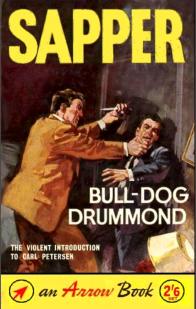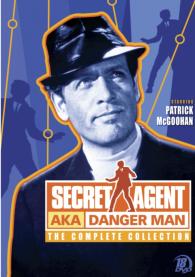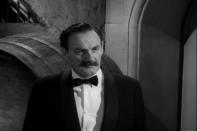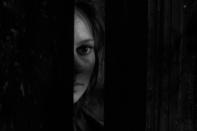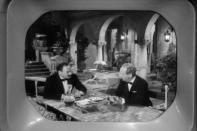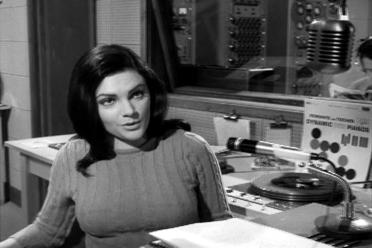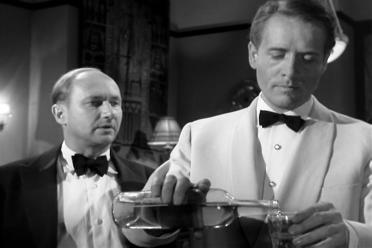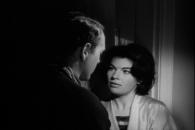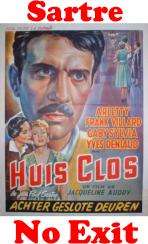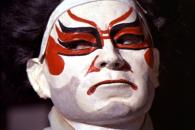§§ Danger Man (later, in the USA, Secret Agent)... two steps from Enid Blyton, one step from Dick Barton, Special Agent? Certainly the pedigree of the first 39 half-hour episodes has the raw semi-tone simplicity of a comic book thriller, embedded in the inter-war UK pulp fiction culture of writers such as Sapper McNeile, John Buchan, Leslie Charteris, Eric Ambler, Helen McInnes, Edgar Wallace... later, Ian Fleming and Graham Greene, so that you might be thinking it's pop-culture rubbish.
The character of John Drake owes a lot to Sapper's Bulldog Drummond -- a pared-down modernist version, hi-tech, moral, subtle... a Cold War version but a Drummond version nonetheless. In The English Lady Takes Lodgers (Series 3, 1965) agent John Drake (Patrick McGoohan) is posing as a penniless novelist in Portugal, when Commander Collinson (Howard Marion-Crawford) -- a criminal who is selling secret weapons technology -- asks him what sort of fiction he writes. Drake is modestly evasive. "I prefer Bulldog Drummond myself," says Collinson, in an amusing sub-textural dig at the character of his adversary.
The early episodes (1960-2) often have a back lot B movie look about them, with certain actors and props rotating through the stories like a travelling theatre troupe. The same 1956 Desoto... the same 1960 Thunderbird... the same German MP 40 sub-machine gun... the same pistol, the same helicopter, the same sandpit and the same old gray sky.
"The eternal quest for melodrama and romance"
If the hunter once rode a horse, in the 20th Century he drives a fast, nimble car. Drummond drives a M.G. sports, and John Drake drives a stable of models, starting with an Aston Martin in the series pilot, View From A Villa... later you see him in an Austin Healy, a Mercedes 190 SL (in his NATO guise), a MGA. and a Mini Cooper (in his "World Travel" London days)... and in The Prisoner, a Lotus 7.
Despite the rough drama of the early episodes, their budget exoticism is enhanced by a number of familiar actors early in their careers. Honor Blackman (James Bond, The Avengers) as Joan Bernard in Colonel Rodriguez (1960); Jackie Collins (Hollywood novelist, sister of Joan) as Lucia in The Contessa (1961); Robert Shaw (James Bond, A Man For All Seasons) as Tony Costello in Bury The Dead (1961); Howard Marion-Crawford (Fu Manchu, Lawrence of Arabia) as Archer in Yesterday's Enemies... Lois Maxwell (James Bond), Charles Gray (James Bond), Donald Pleasance (James Bond, The Night of the Generals), Peter Arne (The Pink Panther), Bill Nagy (Coronation Street, James Bond), Bernard Lee (James Bond, The Third Man), Yvonne Furneaux (La Dolce Vita, Repulsion)... and on and on. Fifty years later, there's a pleasant sense of deja vu when watching Danger Man.
Danger Man follows the conventions of live stage drama closely, favoring interior locations and dialogue-driven action. For example, while the later offshoot series The Prisoner adopted Theatre of the Absurd, Danger Man's absurdism/expressionism is muted by social realism, where the characters are often driven by class anxiety as much as Cold War ideology. The spy gadgets and femme fatales often distract you from the sociology, the post-colonial rapprochement and the new liberalism. Treason has become a crime of class revolt, legitimate for some, easy cash for others. While the class argument is never as full-blooded as in Look Back In Anger, it is often present in the clash between characters and countries. If George Orwell had been a secret agent, he would've been John Drake.
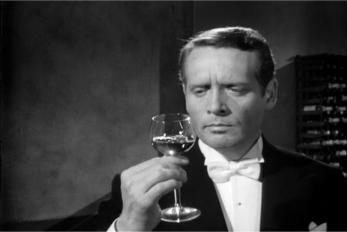
§ One superb example is "No Marks For Servility" where Drake goes undercover as an English butler in a Roman villa rented by the sociopathic Balkan villain Grigori Benares (Howard Marion-Crawford). Benares is essentially a high-level swindler and misogynist, and unfortunately his manipulative charm has allowed him to bag a pretty young English wife. While his international graft is serious enough for M 9 to send in Drake to thwart his latest scam, all this becomes secondary to the clash between Benares and Drake, between master and servant, and the fate of Helen (Suzan Farmer).
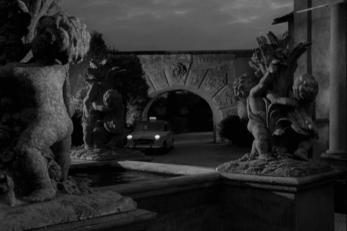
"Let's see what I'm paying $1500 a month for"
Benares obtains a short-term lease on a Roman villa from Sir Charles Fielding, a collector of antiquities who happens to be a friend of M (Peter Madden), Drake's boss. M decides to insert Drake into the Benares household as a butler to spy on Benares and if possible thwart his criminal activities. Drake has an immediate empathic relationship with the pretty but insecure Helen Benares, which does not go unnoticed by her domineering husband, who is always in a high state of alert... quite possibly because, like Drake, he too is an imposter. As M says, "Benares, nationality unknown... he carries many passports... a vulgarian who likes to display his wealth."
When Benares arrives at the villa and finds only Drake the butler there to greet him, he says to his naive wife, "I would've liked all the servants here to greet you." When she demurs, he says, "It's a civilized custom, honey." He turns to Drake, says, "Perhaps you haven't come across it, Drake."
Drake: Oh yes I
have, sir -- in the cinema.
Benares: (stiffens) What exactly do you
mean by that --
Drake: Forgive me, sir. I didn't wish to be
facetious.
Benares: I'm glad to hear that, Drake. I'm the one who
makes the cracks around here and you're the one who laughs.
Joe Orton? Not quite, although the menace and farce unfold in a similar manner. Benares left Athens in a hurry -- interrupting his honeymoon -- because he'd driven a compromised local politician to suicide. Predators have no conscience.
His character is brilliantly portrayed by Howard Marion-Crawford, an effortless UK actor well-known in the 30s, 40s and 50s for his radio drama work (he played Watson in Sherlock Holmes), and to a lesser extent as Dr. Petrie in the Fu Manchu films. Of passing interest is that one of his ancestors, the American sculptor Thomas Gibson Crawford, moved to Rome in 1830 where he lived and worked for a number of years in The Villa Negroni, which might have given Ralph Smart, the DD series creator and writer for No Marks For Servility, the idea for his Renaissance noir setting. Marion-Crawford was also a friend of Winston Churchill, and indeed they have similar intonations. There's a sense, too, that Benares might've understudied an American gangster. As a cunning bully, his characterization of Benares is a perfect foil for McGoohan's John Drake, and a true test of the agent's pragmatic self-discipline. When Drake hears Benares slapping his young wife around, he's only stopped from intervening (and blowing his cover) by the sound of the doorbell.
When the British financier Armstrong (Mervyn Johns) arrives with his pretty daughter Judy (Francesca Annis), the class-barrier once again dissolves as Judy, attracted to Drake, decides he's too hip to be a butler. It's as if she senses the masquerade, or recognizes the redundancy of the entire social convention. So now Drake has two women to protect, and protect them he does. After 40 or 50 or so episodes of Danger Man, you might be immune to the humour of his spy gadgets and techno subterfuges, yet is there anything as funny as Drake the stately butler descending into the wine cellar where he pours himself a tall glass of Primitivo red, lights a cigar, settles down in an armchair to watch and listen to Benares pitch his scam to Armstrong after dinner on the patio... or the two young women discussing whatever, all this over a retro CCTV unit of 4 monitors installed in a wine barrel? For the times, it was science fiction, yet credible and possible. Drake's unflappable manner becomes the epitome of cool. He is still in the thrall of the secret agent life-style, has not reached the Orwellian black hole that surveillance and counter-surveillance becomes in The Prisoner.
The Film Noir aspects of this episode become really apparent when Drake spots Benares using a semaphore lamp to signal to someone in an abandoned property several blocks away. Using a local street map and some basic triangulation, Drake determines the locale. The action is all moonlight and shadows. Drake scales the wall, drops into the ruined garden, gains entrance to the house, wearing his butler's black bowler hat and packing an umbrella (surely a model for Patrick McN in The Avengers). An owl cries. Like a well-dressed truant looking for someplace to kip, he cases the joint, moving stealthily through the noir geometrics. An unattended pot of soup simmers... an empty gun holster hangs from a peg... the stairs ascend into darkness... a dimly lit corridor, a sinister door... the house hangs in the void like a monument to cubism.
The chiaroscuro cine is superb. A lot of TV drama was shot in Super 16, but for Danger Man/Secret Agent it was all 35 mm (4:3 ratio) under the excellent direction of Brendan J. Stafford. In the 60s, watching this on a 21 inch vacuum tube television simply didn't reveal the true beauty of the cinematography, the monochromatic artistry that lies within every frame. Looking at Danger Man today on a 40+ LCD or plasma screen is like exchanging a postcard for the real thing.
Why is Drake here? When Armstrong rejected Benares' bribe of an easy stake in a Circassian coast real-estate development as a quid pro quo for an easy foreign aid loan, Benares reacted to this righteous snub by kidnapping Judy, Armstrong's nubile daughter, holding her captive, bound and gagged to a chair in this moldering den of shadows. The rescue is no problem for Drake -- he has done it before, will do it again. The two thugs are easily tricked, despite the fact they are armed. As usual, the fight choreography has the athletic simplicity of a circus routine, reinforces the anglican view that guns are seldom required for law enforcement. Patrick McGoohan had a Jesuit's insistence that guns rarely needed to be used, as if he feared television violence would imprint the next generation. In fact, "No Marks For Servility" is one of the few episodes in which he actually fires a shot, yet when he does, it's just a warning.
Strong characters, great dialogue, outstanding sets and art design, interesting story... No Marks For Servility was written by Ralph Smart -- the series creator and executive producer -- and directed by the accomplished Don Chaffey (who, in a later life, directed -- to his everlasting credit -- Raquel Welch in "One Million Years B.C.").
